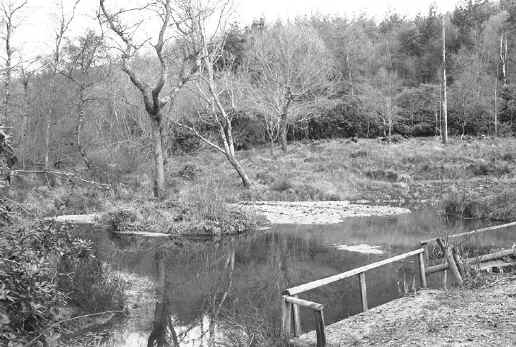|
Flood water leaving Kingfisher Pond after the storms of February 1993 |
The Leat Project
The Problem
|
Flood water leaving Kingfisher Pond after the storms of February 1993 |
| The recently restored wetland habitats at the Woodland
Education Centre were being subjected to massive flooding and siltation. This was
because a leat or man made water channel had fallen into disrepair. As a result,
flood water was no longer diverted along the eastern side of the Centre's steep sided
wooded valley. Before the Leat Project, the Centre's wetland habitats comprised of Kingfisher Pond, a separate Wetland, Marsh and Lake. These were created four years earlier as a result of the Wetlands Restoration Project. The original Leat was constructed in Victorian times when the area which is now the Woodland Education Centre was the pleasure garden of the Victorian cleric Bishop Copleston, who was Bishop of Llandaff. The wetland habitats which were restored were originally the site of two Victorian boating lakes. Before restoration they had completely disappeared except for a small part of the lower lake. This was due to extensive siltation which occurred because the Leat was damaged. The Leat was dug into the hillside above the lakes to take away flood water. In time, the Leat became damaged so that it could no longer function. As a result, the upper lake became completely silted and colonized by Rhododendron. Only one third of the lower lake remained and this too would soon be lost. However in 1986 work started which resulted in the restoration of the lower lake. At the upper lake site a Wetland, a pond (Kingfisher Pond) and a separate Marsh were created. By February 1993 the damaging siltation process had started again. Kingfisher pond, the most northerly of the wetland habitats, became a third full of silt within a week. If no action had been taken not only would this pond have been lost but all the other habitats down stream would have once again become silted. As a short term measure Kingfisher Pond was dug out again by a mechanical digger. Clearly this problem had to be prevented. The only way to stop the silting problem in the long term, was to repair the Leat. The Leat Restoration Project was funded by BT and the Department of the Environment through the Local Projects Fund (LPF). This is assessed by CSV Environment and administered by the Civic Trust. The Offwell Woodland and Wildlife Trust also contributed from its own financial reserves. |
 |
Kingfisher Pond after the storms of February 1993. Note the build up of silt at the back of the island. |